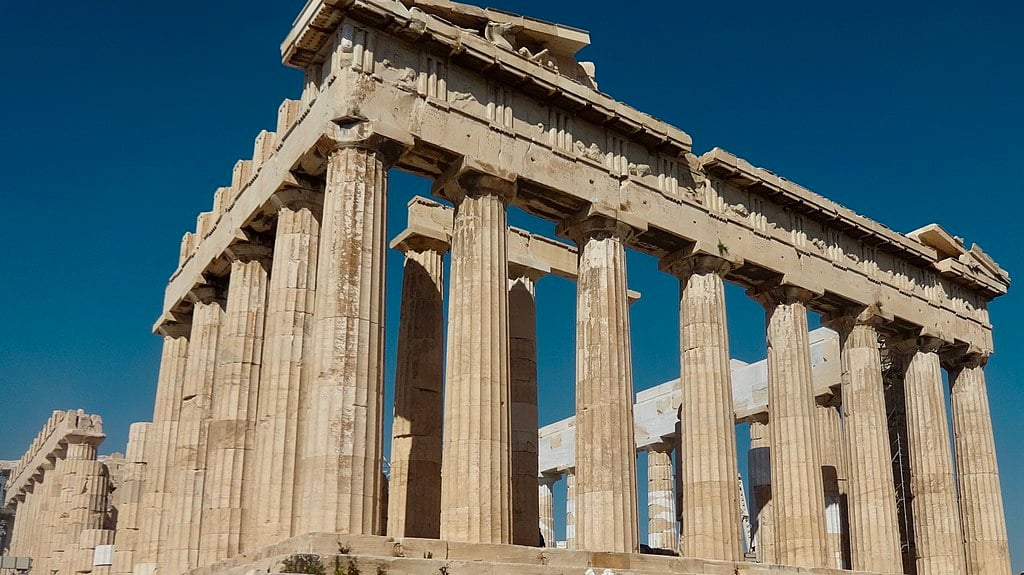

The way the interior of the Parthenon on the Acropolis of Athens was lit has intrigued historians and archaeologists for years, especially how the ancient Greeks illuminated the grand statue of the goddess Athena Parthenos. Now, Archaeologist Juan De Lara of Oxford University Unveils the Mystery Behind the Ancient Greek Lighting System Designed to Highlight the Grand Statue.
The colossal statue of Athena Parthenos that adorned the Parthenon—meaning Athena the Virgin in Greek, hence the temple’s name—was made of ivory and gold. Renowned sculptor Phidias created it in c. 438 BCE using materials chosen for their luminance.
De Lara has recently published his study in the scientific journal The Annual of the British School at Athens. An expert in 3D design and CGI, he says that he has always been fascinated by the Parthenon “due to its central role as a reference point in the history of art and architecture” and how the ancient Greeks lit the place that held the 12-meter-high (118 feet) emblematic statue.
Using cutting-edge digital tools, the archaeologist recreated the temple’s structure, including the goddess statue, with a margin of error of only 2 centimeters. He then calculated the sun’s position at different times of the year and day, according to values from the 5th century BCE.
He concluded that the sun would appear on the horizon on the morning of the Panathenaic procession. Its light would enter through the temple’s large door, reflecting on the statue and amplifying the visual effect of the natural lighting, creating a magical and unique aura.

De Lara believes that the Parthenon was not only an architectural feat, but also an optical one. Almost like a theatrical stage, it was cleverly designed to redirect light, create sacred atmospheres, and connect the visitor with the divine through special effects, though he notes it must be emphasized that the temple was quite dark.
De Lara says that the visual experience of each temple in Ancient Greece and the rituals depended on the deity worshiped in the temple. Temples also varied significantly by factors such as the cult’s origins and the temple’s geographical context. From the fifth century BCE and moving toward the Hellenistic period, there’s a marked increase in a conscious staging of the religious experience.
After the victory of the Greeks over the Persians in the Greco-Persian wars, the Athenians built the Parthenon to honor their leading goddess of war and wisdom. Though it is temple-like in structure, the Parthenon had no official priestess.
The statue of Athena Parthenos was created during the High Classical Greek period, around the 5th century BCE. This era of Greek sculpture is characterized by serene facial expressions, defined fabric drapery, and stark attention to detail.
The chryselephantine sculpture of Athena in the Parthenon represents all of these traits. Her face is composed yet powerful, and the fabric of her dress is stylized. The statue depicts the glory of the Golden Age of Athens under Pericles, and her power as the goddess of war and wisdom.
Athena’s face and arms were crafted from ivory. Curator of antiquities Kenneth Lapatin conducted a detailed study of the chryselephantine statue and suggested that Phidias may have used a technique involving unrolling the ivory and then softening it, possibly using a controlled heating process, to create veneers that were glued together.

De Lara suggests that the materials used for Athena Parthenos were chosen for their inherent luminosity. Marble, gold, and ivory have this property.
When finely worked and polished, each substance can reflect and refract light. Upon entering the Parthenon, one observes the visual effect of dynamic reflectivity: the statue of Athena appears to emerge gradually from the surrounding darkness—a true epiphanic vision, De Lara explains.
De Lara says the architectural response to light varies between civilizations and religions. Religious systems differ in their understanding and use of light. For instance, the Greek conception of sunlight differs significantly from Egypt’s. Although the two civilizations may share architectural expressions in form and orientation, their cosmologies differ.
The archaeology professor sees a relationship between sunlight, architecture, and religious symbolism across the Mediterranean basin as part of a broader cultural continuum. He also says we must add Mesopotamia and India to the exchange, regions with important cultural and intellectual relations with ancient Greece.
